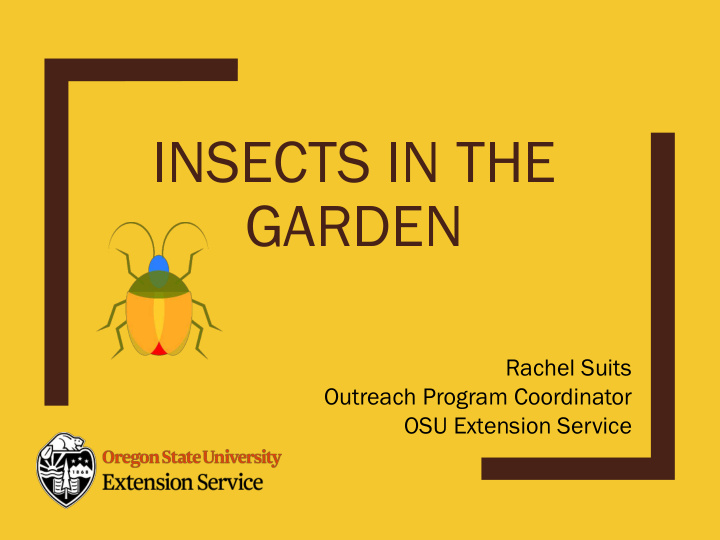



INSECTS IN THE GARDEN Rachel Suits Outreach Program Coordinator OSU Extension Service
Objectives ■ Understand basic insect morphology and physiology. ■ Understand the different niches that insects occupy in an ecosystem. ■ Be able to infer a niche based on mouthparts and other identifying characteristics. ■ Learn and teach identifying characteristics for insect orders.
OVERVIEW 1.What is an insect? 2.Insect biology 3.Diversity & Classification
Fun insect facts ■ Coevolved to pollinate ■ About 80% of the plants Earth’s animals are insects ■ An important food source for many other ■ 1 million species animals described ■ Soil: help aerate the ■ Most insects are soil, improve its beneficial. Only retention of rainwater, about 1-3% of and enhance its tilth insects are pests (physical condition).
Why do Insects Exist? ■ Insects are involved in every aspect of life – Decomposition – Population control – Supporting food chains – Agriculture – Pollinators 6
Important because… 8
Most concentrated energy
THE INSECT APOCALYPSE IS HERE November 27, 2018
Insect Vectored Illnesses WEST NILE MALARIA CHAGAS ZIKA DENGUE LYME FEVER
12
Arthropods (Insects & their relatives) No backbone (invertebrates) Exoskeleton Jointed legs Segmented
ANIMALS ARTHROPODS INSECTS ARACHNIDS MYRIAPODS spider ers lady y beetles etles millipe pedes es stink nk bugs mites centipedes tipedes
What are Arachnids? ■ Arthropod, Non-insect ■ 2 body regions ■ 8 legs ■ No wings ■ No antennae Spiders, mites, ticks & scorpions
What are Myriapods? ■ Arthropod, Non- insect ■ Many body segments ■ 1 pair of antennae “recycler” ■ Many legs predator – Millipedes = 2 pairs/segment – Centipedes = 1 pair/segment
Exoskeleton 3 body segments Compound Eyes 1 pair of antennae 3 pairs of legs Adults have wings 17
Ex Exosk oskele eleton on 18
Molting ■ Process to shed exoskeleton, usually to expand or become adults ■ Regulated by hormones – Some insecticides mimic these insect hormones to disrupt development
Exoskeleton 3 body segments Compound Eyes 1 pair of antennae 3 pairs of legs Adults have wings 20
Head Thorax Abdomen 21
Exoskeleton 3 body segments Compound Eyes 1 pair of antennae 3 pairs of legs Adults have wings 22
Head 23
Exoskeleton 3 body segments Compound Eyes 1 pair of antennae 3 pairs of legs Adults have wings 26
Thorax 27
Sc Scale ales: s: On On the the wi wings ngs of of Bu Butt tter erfl flies ies an and d Moth ths http:/ p://ww /www.vqr qronl nline ne.org/ g/vqr qr-por portf tfolio/scal io/scales es-wings wings-but utter erfl flies es-and and-mo moths ths
Leg Quiz! Types of Legs
Abdomen 30
Insects breathe through spiracles
Mo Mouthpa uthparts ts Stylet Palpus • sucking • sponging Mandibles • chewing 33
Feeding Categories de defoli liation ation paras pa asit itoid oid min inin ing ga gall maker er lea eafroller oller sucking ing
Feeding Categories de defoli liation ation paras pa asit itoid oid min inin ing ga gall maker er lea eafroller oller sucking ing
Feeding Categories de defoli liation ation paras pa asit itoid oid min inin ing ga gall maker er lea eafroller oller sucking ing
Feeding Categories de defoli liation ation paras pa asit itoid oid min inin ing ga gall maker er lea eafroller oller sucking ing
Feeding Categories de defoli liation ation paras pa asit itoid oid min inin ing ga gall maker er lea eafroller oller sucking ing
Feeding Categories de defoli liation ation paras pa asit itoid oid min inin ing ga gall maker er lea eafroller oller sucking ing
49
Making mummies Videos: Dr. Steven Wratten Photo by R Dufour
Insect Development Metam etamor orphosis phosis Comple plete Simple ple Larva Nymph Pupa Adult Adult 52
53
54
55
instar 3 rd 4 th 2 nd 1 st 5 th 57
58
DIVERSIT SITY Y OF OF SPECIES Hemipt iptera era, , Other er, , 7.70% 7.80% Lepidopt idoptera era, , 15.90% Coleopt eoptera ra, , Hymen enopt optera ra 41. 1.20% 20% , 14.90% , 0% Diptera era, , 12.40% 59
CHEWING yes no defoliation leafroller mining SUCKING beetle caterpillar grasshopper caterpillar fly caterpillar yes no True bug Aphid/LH mite GALL Plant Damage Decision Tree yes no mite wasp Disease?
Entomology resources ■ PNW handbook: https://pnwhandbooks.org/insect ■ Bugguide.net ■ Xerces Society: www.xerces.org ■ OSU Online Insect Collection: http://oregondigital.org/sets/ken-gray 62
Recommend
More recommend